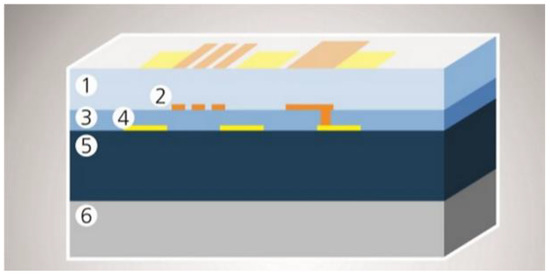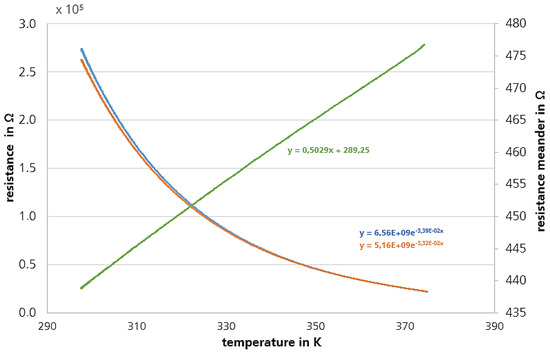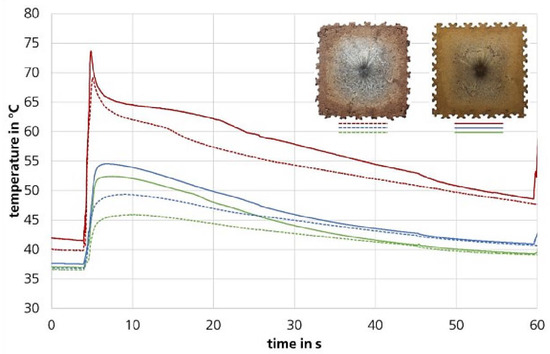Abstract
The investigation of wear resistant thin film sensor systems for the detection of temperature and melt distributions on the surface of an injection mold for the optimization of natural fibre reinforced plastic production is the theme of this paper.
1. Introduction
From several perspectives the integration of renewable raw materials in plastics is a very important development objective for our time. From the ecological perspective, an ever-increasing proportion of plastic can be countered with recyclable natural fiber reinforced plastics. From an economic perspective, new material composites are being developed which are of great interest for the automotive industry and the lightweight sector. However, for the production of such natural fiber reinforced plastic parts in injection molding processes, increased wear occurs in the mold, and this in turn results in shorter tool life, which causes process costs to increase significantly. Innovative, multifunctional film systems are in development that analyze and optimize the injection molding process by thermo-resistive thin film sensor structures in a wear resistant coating system.
2. Materials and Methods
A new thin film layer system is in development which combines wear resistance with thermoresistive sensor behaviour in one layer system (Figure 1). On steel inserts (6) that can easily be installed in the injection mold, the thermo-resistive and wear-resistant hydrogenated carbon film (5) is deposited homogeneously in the thickness of 6 µm as base layer. This layer has a hardness of 24 GPa, a coeffiction of friction against steel under 0.2 and is deposited by plasma enhanced chemical vapour deposition (PECVD). It is a further development of the well known Diamond Like Carbon (DLC) layer [1,2]. On this coating individual chromium electrode structures (4) are fabricated. Therefore, a homogeneous chromium layer in a thickness of 200 nm is deposited by a physical vapour deposition (PVD) process directly on the ground layer. By photolithography a mask out of photoresist is fabricated onto the chromium layer and the area which is unprotected by photoresist got removed by chemical wet etching. This is followed by an intermediate insulating coating out of alumina or out of a silicon and oxygen modified carbon layer (3). The alumina layer is deposited in a PVD process, the silicon and oxygen modified carbon layer is fabricated by PECVD. Both coatings are deposited in a thickness of about 1 µm. A second chromium layer (thickness 200 nm) is coated in the next step and got structured, so that conductive traces from the electrodes to the contacting areas and also a temperature sensor in meander geometry (2) are manufactured by photolithography and chemical wet etching. At last a wear resistant top coating (1) is deposited in a thickness of 3 µm. Therefore, on some inserts alumina was used and also the silicon and oxygen modified carbon layer was deposited. The entire film system has a thickness of approximately 10 µm.

Figure 1.
Schematic description of the multifunctional thin film layer system.
A mold insert with a complete film system, in which alumina is deposited as insulating intermediate and top coating, is presented in Figure 2b. The two circular areas in the photomicrograph are the thermo-resistive sensor areas with negative temperature coefficient (NTC sensor) that are half-enclosed by the meander-shaped structure with positive temperature coefficient (PTC sensor) also used for temperature detection.

Figure 2.
Photomicrograph of the three thermoresistive sensor structures is shown in (a) and the whole mold insert in (b).
In a furnace the thermoresistive behaviour of all sensor structures is characterized.
Therefore, the coated mold inserts are integrated with a Pt100 reference resistor in direct touch with the multifunctional layer system. In Figure 3 the characteristic curves from the sensor structures of one sensor insert are shown exemplary. The meander structure out of chromium shows a linear resistance dependency on the temperature and the two circular structures show the exponential resistance dependency on the temperature as it is well known from semiconductors.

Figure 3.
Characteristic resistance dependencies of the three sensor structures.
3. Results
Figure 4a shows three integrated sensor modules in the mold and the color positioning of them Figure 4b. The left sensor insert is coated with the silicon and oxygen modified carbon layer as intermediate and top layer and is arranged directly at the nozzle, so these sensor structures get at first in touch with the natural fiber reinforced polymer melt. At second the sensor structures in the blue area of the sensor insert, arranged at the middle of the right side, get in contact with the melt. This insert as well as the third insert, placed above on the right side, are coated with alumina as insulating intermediate and top layer. The sensor structures in the green area of the third insert are nearby the edge of the mold and get at last in touch with the modified polymer melt. That is very important for the interpretation of Figure 5.

Figure 4.
(a) Three integrated sensor modules in the polymer injection mold; (b) Color positioning of the three sensor areas.

Figure 5.
Temperature distribution in dependence on the time for two injection molding processes. Dotted line is the not perfectly fabricated part.
The measurement results of one circular NTC sensor structure of each insert for two different injection molding processes are combined in Figure 5. The compound used in these tests was a mixture out of polyvinyl chloride (PVC) as basic material with 55% wood fiber as filler material. The diagram shows the temperature distribution in the mold for a well formed part (constant line) and a not perfectly fabricated part (dotted line). For the well formed part the temperature sensors measure in every area higher values.
4. Discussion
The measurement results in Figure 5 show that directly the first contact of the melt with the sensory layer system causes a steep increase of temperature in every position. The comparison of the two different injection molding processes shows that the sensor structures are so sensitive that they can be used as an indicator for the quality of the produced part. During the first 300 injection molding processes the layer systems show no wear independent on the top coating. The long time stability of these multifunctional layer systems has to be tested for the natural fiber reinforced plastic production.
5. Conclusions
The reduction of plastic waste is an important theme in daily life. One solution is the replacement of polymers by natural materials. The investigation of new compounds with a high filling degree of natural fibers for polymer injection molding is a possible way. These natural fibers like e.g., wood fibers cause an increased wear in the mold of the machine. The implementation of new injection molding parameters can be improved by the integration of thin film sensor systems directly in contact with the modified melt in the mold. With these novel sensor inserts the measurement of the temperature distribution and also the filling degree in the mold directly during the process is possible in combination with a reduction of wear.
Author Contributions
N.P. designed and fabricated all sensor structures. E.M.-K. is responsible for the characterisation of all sensor systems. S.B. coordinates the project and wrote the paper.
Acknowledgments
The results described were achieved within the project “Smart coating systems for process control and increased wear resistance in processing of natural fiber reinforced polymers”, or in short “Smart NFR”, in which the Fraunhofer IST is working jointly with the Fraunhofer Institute for Machine Tools and Forming Technology (Fraunhofer Institut für Werkzeugmaschinen und Umformtechnik (IWU)) and Tomas Bata University in Zlín in the Czech Republic. Smart NFR is funded in the 19th Cornet Call (Collective Research Networking) through the Federal Ministry for Economic Affairs and Energy (BMWi) and the German Federation of Industrial Cooperative Research Associations (Arbeitsgemeinschaft industrieller Forschungsvereinigungen e.V. (AiF), and the project will run from 06/01/2016 to 11/30/2018.
Conflicts of Interest
The authors declare no conflict of interest.
References
- Griffiths, C.A.; Dimov, S.S.; Rees, A.; Dellea, O.; Gavillet, J.; Lacan, F.; Hirshy, H. A novel texturing of micro injection moulding tools by applying an amorphous hydrogenated carbon coating. Surf. Coat. Technol. 2013, 235, 1–9. [Google Scholar] [CrossRef][Green Version]
- Bewilogua, K.; Hofmann, D. History of diamond-like carbon films—From first experiments to worldwide applications. Surf. Coat. Technol. 2014, 242, 214–225. [Google Scholar] [CrossRef]
Publisher’s Note: MDPI stays neutral with regard to jurisdictional claims in published maps and institutional affiliations. |
© 2018 by the authors. Licensee MDPI, Basel, Switzerland. This article is an open access article distributed under the terms and conditions of the Creative Commons Attribution (CC BY) license (https://creativecommons.org/licenses/by/4.0/).